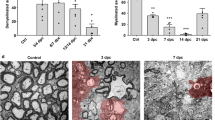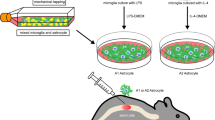Summary
The ethidium bromide model of demyelination/remyelination provides a system for studying the interactions between demyelinated axons, host glia and transplanted glia. The injection of 0.1% ethidium bromide in isotonic saline into the white matter of the spinal cord produces a glia-free demyelinating lesion which is subsequently remyelinated by Schwann cells and, to a lesser extent, oligodendrocytes. Thein vitro description of an oligodendrocyte progenitor isolated from the adult CNS, together with the recognized role of type-1 astroctyes in controlling the developmental programme of perinatal O-2A progenitors, suggested the possibility that transplanted type-1 astrocytes may potentiate oligodendrocyte remyelination of the ethidium bromide lesion. Purified type-1 astrocyte cultures were prepared by removing cells of the oligodendrocyte lineage using a combination of exposure to cytosine arabinoside and complement-mediated immunocytolysis. Following transplantation of purified type-1 astrocyte cultures into ethidium bromide lesions, a significant increase in the extent of oligodendrocyte remyelination was achieved. Because the purified type-1 astrocyte cultures had no demonstrable oligodendrocyte-generating potential it was concluded that the additional oligodendrocytes appearing in the type-1 astrocytes transplanted lesion were of host origin. These results indicate that type-1 astrocytes can facilitate repair of demyelinating lesions by host oligodendrocytes. The possible mechanisms whereby this facilitation occurs are discussed.
Similar content being viewed by others
References
Blakemore, W. F. (1976) Invasion of Schwann cells into the spinal cord of the rat following local injections of lysolecithin.Neuropathology and Applied Neurobiology 2, 21–39.
Blakemore, W. F. (1978) Observations on remyelination in the rabbit spinal cord following demyelination induced by lysolecithin.Neuropathology and Applied Neurobiology 4, 47–59.
Blakemore, W. F. (1982) Myelination, demyelination and remyelination in the CNS. InRecent Advances in Neuropathology 2 (edited byThomas-Smith, W. &Cavanagh, J. B.) pp. 53–82. Edinburgh: Churchill Livingstone.
Blakemore, W. F. (1984) Limited remyelinaiton of CNS axons by Schwann cells transplanted into the subarachnoid space.Journal of the Neurological Sciences 64, 265–76.
Blakemore, W. F. &Crang, A. J. (1985) The use of cultured autologous Schwann cells to remyelinate areas of persistent demyelination in the central nervous system.Journal of the Neurological Science 70, 207–23.
Blakemore, W. F., Crang, A. J. &Patterson, R. C. (1987) Schwann cell remyelination of CNS axons following injection of cultures of CNS cells into areas of persistent demyelination.Neuroscience Letters 77, 20–4.
Blakemore, W. F. &Crang, A. J. (1988) Extensive oligodendrocyte remyelination following injection of cultured central nervous system cells into demyelinating lesions in adult central nervous system.Developmental Neuroscience 10, 1–11.
Blakemore, W. F. &Crang, A. J. (1989) The relationship between type-1 astrocytes, Schwann cells and oligodendrocytes following transplantation of glial cell cultures into demyelinating lesions in the adult rat spinal cord.Journal of Neurocytology 18, 519–28.
Bunge, R. P. &Bunge, M. B. (1978) Evidence that contact with connective tissue matrix is required for normal interaction between Schwann cells and nerve fibres.Journal of Cell Biology 78, 943–50.
Crang, A. J. &Blakemore, W. F. (1989) The effect of the number of oligodendrocytes transplanted into X-irradiated, glial-free lesions on the extent of oligodendrocyte remyelination.Neuroscience Letters 103, 269–274.
Eisenbarth, G. S., Walsh, F. S. &Nirenberg, M. (1979) Monoclonal antibody to a plasma membrane antigen of neurons.Proceedings of the National Academy of Sciences (USA) 76, 4913–17.
Fawcett, J. W., Housden, E., Smith-Thomas, L. &Meyer, R. L. (1989) The growth of axons in three dimensional astrocyte cultures.Developmental Biology 135, 449–58.
Ffrench-Constant, C. &Raff, M. C. (1986) Proliferating bipotential glial progenitor cells in adult rat optic nerve.Nature 319, 499–502.
Godfraind, C., Friedrich, V. L., Holmes, K. V. &Dubois-Dalcq, M. (1989)In vivo analysis of glial cell phenotypes during a viral demyelinating disease in mice.Journal of Cell Biology 109; 2405–16.
Gout, O., Gansmuller, A., Baumann, N. &Gumpel, M. (1988) Remyelination by transplanted oligodendrocytes of a demyelinated lesion in the spinal cord of the adult shiverer mouse.Neuroscience Letters 87, 195–9.
Graça, D. L. &Blakemore, W. F. (1986) Delayed remyelination in rat spinal cord following ethidium bromide injection.Neuropathology and Applied Neurobiology 12, 593–605.
Gumpel, M., Gout, O., Lubetski, C., Gansmuller, A. &Baumann, N. (1989) Myelination and remyelination in the central nervous system by transplanted oligodendrocytes using the shiverer model.Developmental Neuroscience 11, 132–9.
Ludwin, S. K. (1987) Remyelination in demyelinating diseases of the central nervous system.CRC Critical Reviews in Neurobiology 3, 1–28.
Ludwin, S. K. (1989) Evolving concepts and issues in remyelination.Developmental Neuroscience 11, 140–9.
Ludwin, S. K. &Bakker, D. A. (1988) Can oligodendrocytes attached to myelin proliferate?Journal of Neuroscience 8, 1239–44.
Noble, M. &Murray, K. (1984) Purified astrocytes promote thein vitro division of a bipotential glial progenitor cell.EMBO Journal 3, 2243–7.
Noble, M., Murray, K., Stroobant, P., Waterfield, M. D. &Riddle, P. (1988) Platelet-derived growth factor promotes division and motility and inhibits premature differentiation of the oligodendrocyte/type-2 astrocyte progenitor cell.Nature 333, 560–5.
Ranscht, B., Chapshaw, P. A., Noble, M. &Seifert, W. (1982) Development of oligodendrocytes and Schwann cells studied with a monoclonal antibody to galactocerebroside.Proceedings of the National Academy of Sciences (USA) 79, 2709–13.
Raff, M. C., Miller, R. H. &Noble, M. (1983) A glial progenitor cell that developsin vitro into an astrocyte or an oligodendrocyte depending on culture medium.Nature 303, 390–6.
Richardson, W. D., Pringle, N., Mosley, M. J., Wester-Mark, B. &Dubois-Dalcq, M. (1988) A role for platelet-derived growth factor in normal gliogenesis in the central nervous system.Cell 53, 309–19.
Rosen, C. L., Bunge, R. P., Ard, M. D. &Wood, P. M. (1989) Type-1 astrocytes inhibit myelination by adult rat oligo-dendrocytesin vitro.Journal of Neuroscience 9, 3371–9.
Smith, M. E. &Eng, L. F. (1988) The development of the gliotic plaque in experimental allergic encephalomyelitis. InCurrent Issues in Neural Regeneration Research (edited byReier, P. J., Bunge, R. P. &Seil, F. J.) pp. 291–300. New York: Alan R. Liss.
Sommer, I. &Schachner, M. (1981) Monoclonal antibodies (O1 to O4) to oligodendrocyte surfaces. An immunocytological study in the central nervous system.Developmental Biology 83, 3121–327.
Trotter, J. &Schachner, M. (1989) Cells positive for the O4 surface antigen isolated by cell sorting are able to differentiate into astrocytes or oligodendrocytes.Developmental Brain Research 46, 115–22.
Weller, R. O. (1990) Demyelinating diseases: multiple sclerosis. InSystemic Pathology, Vol 4;Nervous System, Muscle and Eyes (edited byWeller, R. O.) pp. 224–43. Edinburgh: Churchill-Livingstone.
Wolf, M. K., Brandenberg, M. C. &Billings-Gagliardi, S. (1986) Migration and myelination by adult glial cells: Reconstructive analysis of tissue culture experiments.Journal of Neuroscience 6, 3731–8.
Wolswijk, G. &Noble, M. (1989) Identification of an adult-specific glial progenitor cell.Development 105, 387–400.
Wolswijk, G., Riddle, P. N. &Noble, M. (1990) Coexistence of perinatal and adult forms of a glial progenitor cell during development of the rat optic nerve.Development 109, 691–8.
Wood, P., Okada, E. &Bunge, R. (1980) The use of networks of dissociated rat dorsal root ganglion neurons to induce myelination by oligodendrocytes in culture.Brain Research 196, 247–52.
Wood, P. M. &Williams, A. K. (1984) Oligodendrocyte proliferation and CNS myelination in cultures containing dissociated embryonic neuroglia and dorsal root ganglion neurons.Developmental Brain Research 12, 225–41.
Author information
Authors and Affiliations
Rights and permissions
About this article
Cite this article
Franklin, R.J.M., Crang, A.J. & Blakemore, W.F. Transplanted type-1 astrocytes facilitate repair of demyelinating lesions by host oligodendrocytes in adult rat spinal cord. J Neurocytol 20, 420–430 (1991). https://doi.org/10.1007/BF01355538
Received:
Revised:
Accepted:
Issue Date:
DOI: https://doi.org/10.1007/BF01355538




